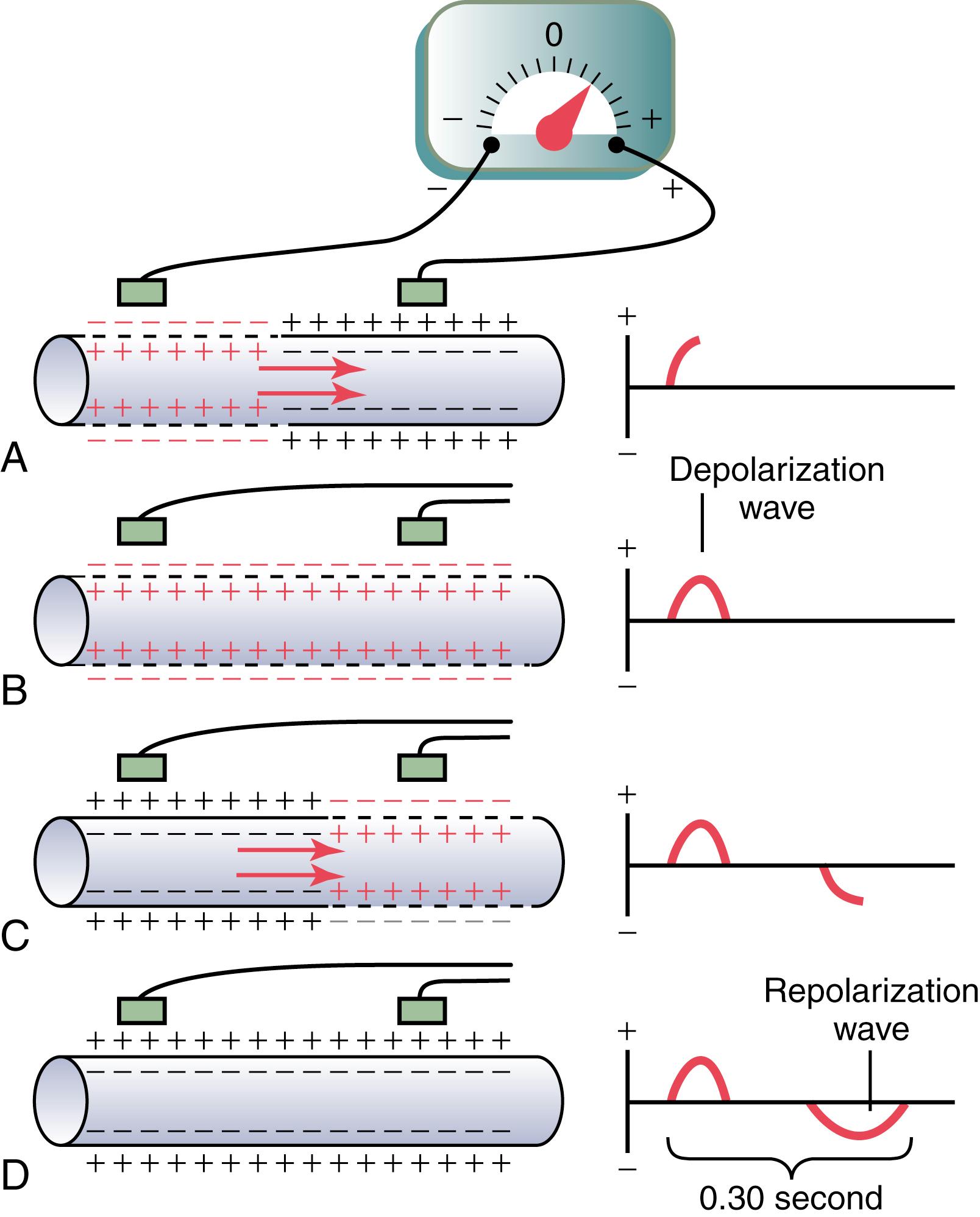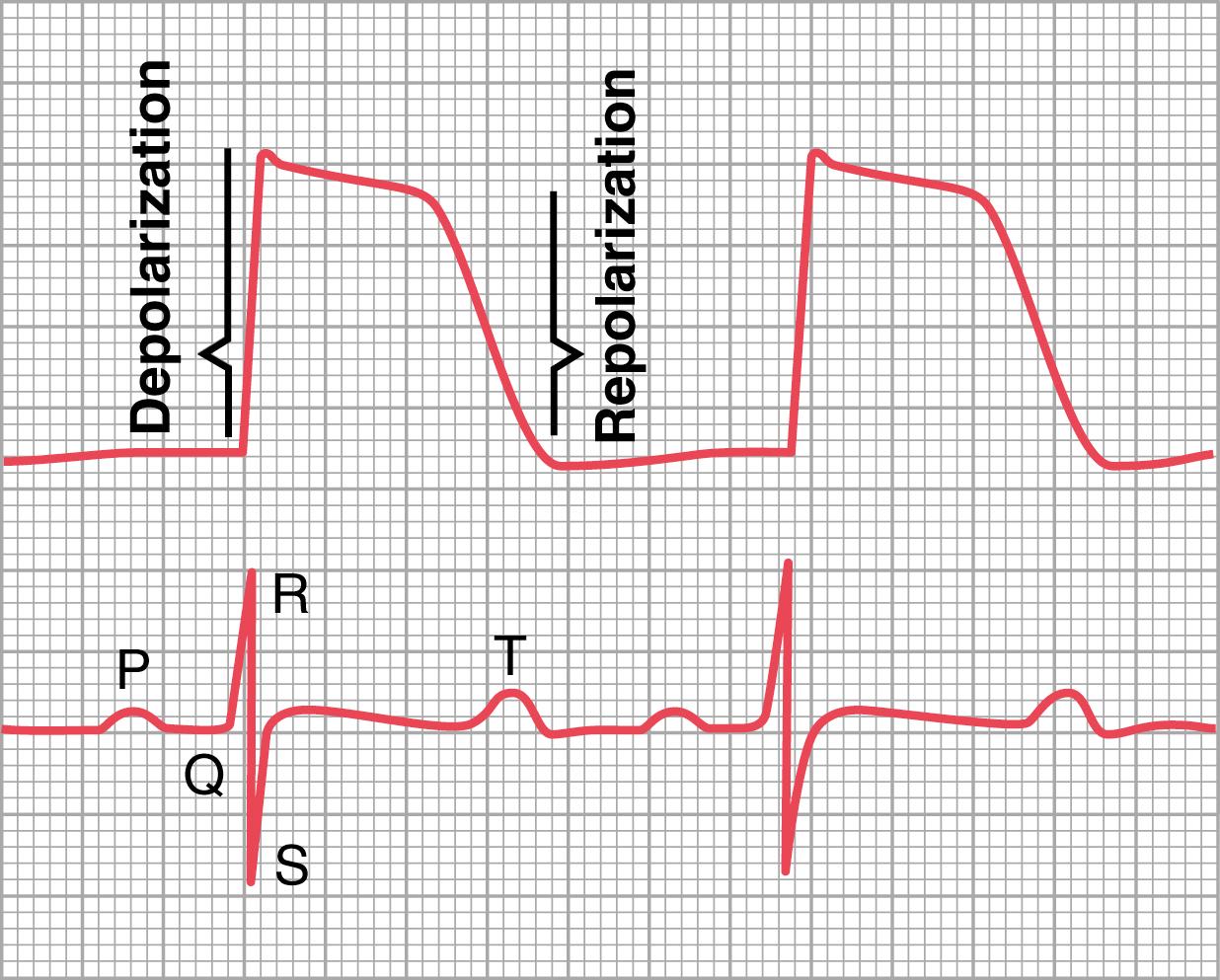Physical Address
304 North Cardinal St.
Dorchester Center, MA 02124
When a cardiac impulse passes through the heart, electrical current also spreads from the heart into the adjacent tissues surrounding the heart. A small portion of the current spreads all the way to the surface of the body. If electrodes are placed on the skin on opposite sides of the heart, electrical potentials generated by the current can be recorded; the recording is known as an electrocardiogram (ECG). A normal ECG for two beats of the heart is shown in Figure 11-1 .
The normal ECG (see Figure 11-1 ) is composed of a P wave, a QRS complex, and a T wave. The QRS complex is often, but not always, three separate waves: the Q wave, the R wave, and the S wave.
The P wave is caused by electrical potentials generated when the atria depolarize before atrial contraction begins. The QRS complex is caused by potentials generated when the ventricles depolarize before contraction—that is, as the depolarization wave spreads through the ventricles. Therefore, both the P wave and the components of the QRS complex are depolarization waves .
The T wave is caused by potentials generated as the ventricles recover from depolarization. This process normally occurs in ventricular muscle 0.25 to 0.35 second after depolarization. The T wave is known as a repolarization wave .
Thus, the ECG is composed of both depolarization and repolarization waves. The principles of depolarization and repolarization are discussed in Chapter 5 . The distinction between depolarization waves and repolarization waves is so important in electrocardiography that further clarification is necessary.
Figure 11-2 shows a single cardiac muscle fiber in four stages of depolarization and repolarization, with the color red designating depolarization. During depolarization, the normal negative potential inside the fiber reverses and becomes slightly positive inside and negative outside.

In Figure 11-2 A , depolarization, demonstrated by red positive charges inside and red negative charges outside, is traveling from left to right. The first half of the fiber has already depolarized while the remaining half is still polarized. Therefore, the left electrode on the outside of the fiber is in an area of negativity, and the right electrode is in an area of positivity, which causes the meter to record positively. To the right of the muscle fiber is shown a record of changes in potential between the two electrodes, as recorded by a high-speed recording meter. Note that when depolarization has reached the halfway mark in Figure 11-2 A , the recording on the right has risen to a maximum positive value.
In Figure 11-2 B , depolarization has extended over the entire muscle fiber, and the recording to the right has returned to the zero baseline because both electrodes are now in areas of equal negativity. The completed wave is a depolarization wave because it results from the spread of depolarization along the muscle fiber membrane.
Figure 11-2 C shows halfway repolarization of the same muscle fiber, with positivity returning to the outside of the fiber. At this point, the left electrode is in an area of positivity, and the right electrode is in an area of negativity. This polarity is opposite to the polarity in Figure 11-2 A . Consequently, the recording, as shown to the right, becomes negative.
In Figure 11-2 D , the muscle fiber has completely repolarized, and both electrodes are now in areas of positivity so that no potential difference is recorded between them. Thus, in the recording on the right, the potential returns once more to zero. This completed negative wave is a repolarization wave because it results from the spread of repolarization along the muscle fiber membrane.
The monophasic action potential of ventricular muscle, discussed in Chapter 10 , normally lasts between 0.25 and 0.35 second. The top part of Figure 11-3 shows a monophasic action potential recorded from a microelectrode inserted into the inside of a single ventricular muscle fiber. The upsweep of this action potential is caused by depolarization, and the return of the potential to the baseline is caused by repolarization.

The lower half of Figure 11-3 shows a simultaneous recording of the ECG from this same ventricle. Note that the QRS waves appear at the beginning of the monophasic action potential, and the T wave appears at the end. Note especially that no potential is recorded in the ECG when the ventricular muscle is either completely polarized or completely depolarized . Only when the muscle is partly polarized and partly depolarized does current flow from one part of the ventricles to another part, and therefore current also flows to the surface of the body to produce the ECG.
Before contraction of muscle can occur, depolarization must spread through the muscle to initiate the chemical processes of contraction. Refer again to Figure 11-1 ; the P wave occurs at the beginning of contraction of the atria, and the QRS complex of waves occurs at the beginning of contraction of the ventricles. The ventricles remain contracted until after repolarization has occurred—that is, until after the end of the T wave.
The atria repolarize about 0.15 to 0.20 second after termination of the P wave, which is also approximately when the QRS complex is being recorded in the ECG. Therefore, the atrial repolarization wave, known as the atrial T wave , is usually obscured by the much larger QRS complex. For this reason, an atrial T wave is seldom observed on the ECG.
The ventricular repolarization wave is the T wave of the normal ECG. Ordinarily, ventricular muscle begins to repolarize in some fibers about 0.20 second after the beginning of the depolarization wave (the QRS complex), but in many other fibers, it takes as long as 0.35 second. Thus, the process of ventricular repolarization extends over a long period, about 0.15 second. For this reason, the T wave in the normal ECG is a prolonged wave, but the voltage of the T wave is considerably less than the voltage of the QRS complex, partly because of its prolonged length.
All recordings of ECGs are made with appropriate calibration lines on the display grid. Historically, ECGs were recorded electronically and printed onto paper; ECGs are now usually displayed digitally. As shown in Figure 11-1 , the horizontal calibration lines are arranged so that 10 of the small line divisions upward or downward in the standard ECG represent 1 millivolt, with positivity in the upward direction and negativity in the downward direction.
The vertical lines on the ECG are time calibration lines. A typical ECG is run at a speed of 25 millimeters per second, although faster speeds are sometimes used. Therefore, each 25 millimeters in the horizontal direction is 1 second, and each 5-millimeter segment, indicated by the dark vertical lines, represents 0.20 second. The 0.20-second intervals are then broken into five smaller intervals by thin lines, each of which represents 0.04 second.
The recorded voltages of the waves in the normal ECG depend on the manner in which the electrodes are applied to the surface of the body and how close the electrodes are to the heart. When one electrode is placed directly over the ventricles, and a second electrode is placed elsewhere on the body remote from the heart, the voltage of the QRS complex may be as high as 3 to 4 millivolts. Even this voltage is small in comparison with the monophasic action potential of 110 millivolts recorded directly at the heart muscle membrane. When ECGs are recorded from electrodes on the two arms or on one arm and one leg, the voltage of the QRS complex usually is 1.0 to 1.5 millivolts from the top of the R wave to the bottom of the S wave, the voltage of the P wave is between 0.1 and 0.3 millivolts, and the voltage of the T wave is between 0.2 and 0.3 millivolts.
The time between the beginning of the P wave and the beginning of the QRS complex is the interval between the beginning of electrical excitation of the atria and the beginning of excitation of the ventricles. This period is called the P-Q interval . The normal P-Q interval is about 0.16 second. (Often, this interval is called the P-R interval because the Q wave is likely to be absent.) The P-R interval shortens at faster heart rates due to increased sympathetic or decreased parasympathetic activity, which increase atrioventricular node conduction speed. Conversely, the P-R interval lengthens with slower heart rates as a consequence of slower atrioventricular nodal conduction caused by increased parasympathetic tone or withdrawal of sympathetic activity.
Contraction of the ventricle lasts almost from the beginning of the Q wave (or R wave, if the Q wave is absent) to the end of the T wave. This interval is called the Q-T interval and ordinarily is about 0.35 second.
Become a Clinical Tree membership for Full access and enjoy Unlimited articles
If you are a member. Log in here